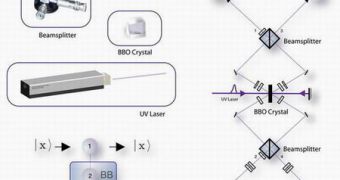It is widely believed that if large-scale quantum computers can be built, they will be able to solve certain problems exponentially faster than any classical computer. Finding a way to build such a computer that works more efficiently than a classical computer has been the holy grail of quantum information processing for more than a decade.
Most researchers seem to think photons will be the next step in computing technology, creating the supercomputers of the future.
Professor Peter Drummond, from the Australian Research Centre of Excellence for Quantum-Atom Optics at The University of Queensland and Dr Piotr Deuar, from Van der Waals Zeeman Institute in Holland, have successfully achieved a collision of two laser beams from an atom laser using only an everyday desktop computer, thus adding another step to the ladder leading to quantum computing.
"Such raw calculations have commonly been assumed intractable, once the number of atoms approaches even a few dozen," Professor Drummond said. "This is because the complexity of the mathematical description grows rapidly with the number of atoms."
So far, the complex calculations needed in order to predict and study information derived from quantum states have required huge processing power, so this is really a simplification of the mathematical work involved.
"We have now succeeded in simulating the collision of two beams from an atom laser, each with hundreds of thousands of particles. This is a major accomplishment, because one of the main arguments for the task of developing quantum computers has been that they might be able to tackle this type of problem, if built."
This is extremely good news for the field of quantum computing, which could mean that this futuristic concept will become less fiction and more science, in the not so distant future. The ability to make such applications work under ordinary conditions is a breakthrough in the field.
"Since quantum computers are still in the future, the approach of using smarter computer software on existing computers seems the only way to make progress on such frontier problems in physics at the present time."

 14 DAY TRIAL //
14 DAY TRIAL //